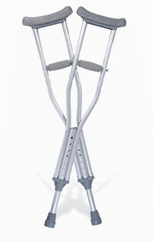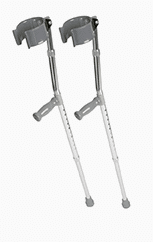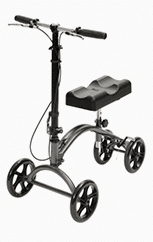
How to Find the Best Mobility Device For You
What is the best traditional crutch alternative?
With so many options, it can be overwhelming trying to decide which mobility device is best for you. We think that when you do the comparisons, the iWALK crutch is the clear winner, but hey, we’re biased. Do you own comparisons, starting with the video below, and decide on the best crutch type for yourself.
What are the Different Types of Crutches?
Almost no one really wants to use traditional crutches, but when you have a foot injury, you may have no choice. The two most common types of crutches are underarm and forearm crutches:
Underarm
This is the traditional type of crutch you’ve seen the most, especially in the US. It has a pad below your armpit and a handle about halfway down the length of the crutch. Underarm crutches can help you balance and almost seem like an extension of your arms.
After using them for some time, however, people often get pain in their wrists, armpits, and hands. The strain on the hands can even create blisters. And you actually need a lot of upper body strength to use them for long. Plus, if you stand still and rest your armpits on the pads, it can injure sensitive nerves there.
Forearm
Forearm crutches are smaller and lighter than underarm crutches, so they’re easier to store and transport than underarm crutches. They each have a handle and a cuff that lightly grips your forearm. Since they don’t reach the armpit area, they can’t cause pain there. But they can still cause blisters on your hands and strain to your wrists.
Alternatives to Crutches
Alternatives to crutches are often larger (except the iWALK crutch). They can be easier to use than crutches, but wheelchairs and knee scooters don’t let you continue your regular activities easily.
Wheelchair
A wheelchair won’t strain your wrists or press on your armpits. It also doesn’t take any balancing or practice to use. Using one by yourself can still take some strength and stamina, though, and it won’t allow you to do certain everyday tasks.
Knee Scooter
Knee scooters don’t strain your hands, which you use to hold onto the handlebars. You might feel unsteady using one, because you have to balance a little, and the wheels can make it feel like it could slide out from under you.
iWALK Crutch
This award-winning device can help if you have an injury below your knee. It’s like a crutch alternative for your leg. It grips your upper leg and holds your lower leg comfortably in a bent position. Then, with a small amount of practice, you can walk normally while using your hands to do everyday tasks and even walk on the stairs. The iWALK crutch is also easy to adjust and store.
A foot injury can disrupt your life. We get it. Crutches, the iWALK crutch, and other devices can give you a lot of your mobility back while you’re healing. But only the iWALK crutch, the ultimate alternative to crutches, lets you walk normally while still using your hands to walk the dog, cook, shop, and work.
Comparison
Need more specific comparisons for alternative types of crutches for non-weight bearing? Click on any of the devices below to see specific comparisons between that device and the iWALK crutch, or scroll down to see a general side by side comparison of what you can do (and can’t do) using the most popular mobility devices.
Mobility Device Comparison Chart
| UNDERARM CRUTCHES | FOREARM CRUTCHES | KNEE SCOOTER | iWALK CRUTCH | |
| NON-WEIGHT BEARING | ||||
|---|---|---|---|---|
| PAIN FREE | ||||
| HANDS FREE | ||||
| FUNCTIONAL DURING REHABILITATION | ||||
| ABILITY TO BE INDEPENDENT | ||||
| REDUCED MUSCLE ATROPHY | ||||
| PARTIAL ELEVATION OF INJURY | ||||
| REDUCED RECOVERY TIME POTENTIAL | ||||
| IMPROVED EMOTIONAL WELL BEING | ||||
| IMPROVED ABILITY TO EXERCISE |
iWALK Crutch – The Clear Winner
It’s no contest. When it comes to hands free, pain free, functional mobility there is no comparison – the iWALK crutch outperforms any crutch options, knee scooters and every other mobility device, hands down. And hands free!
Learn more about the award winning iWALK crutch.
Free 1-3 Day Delivery
to most US locations





